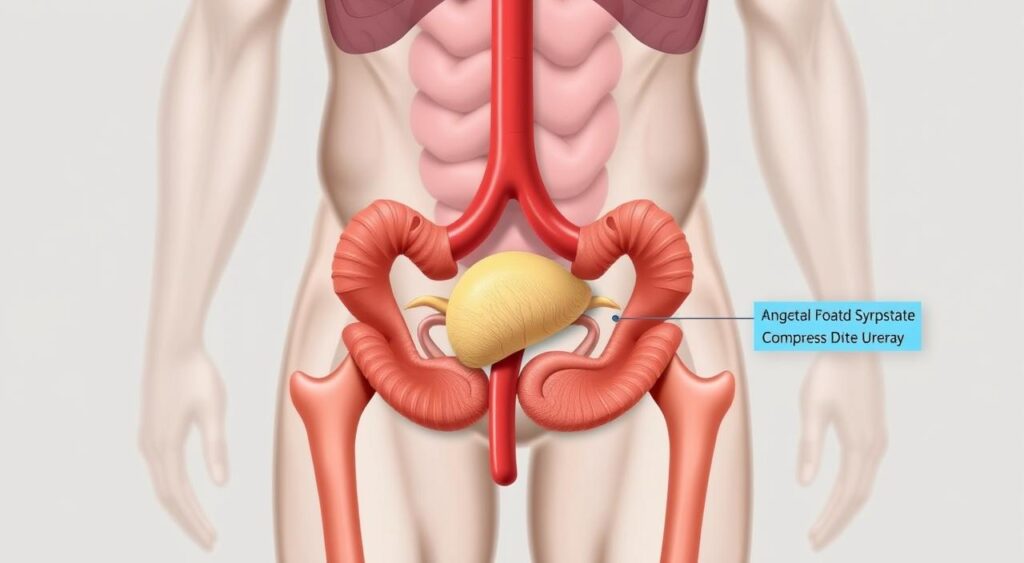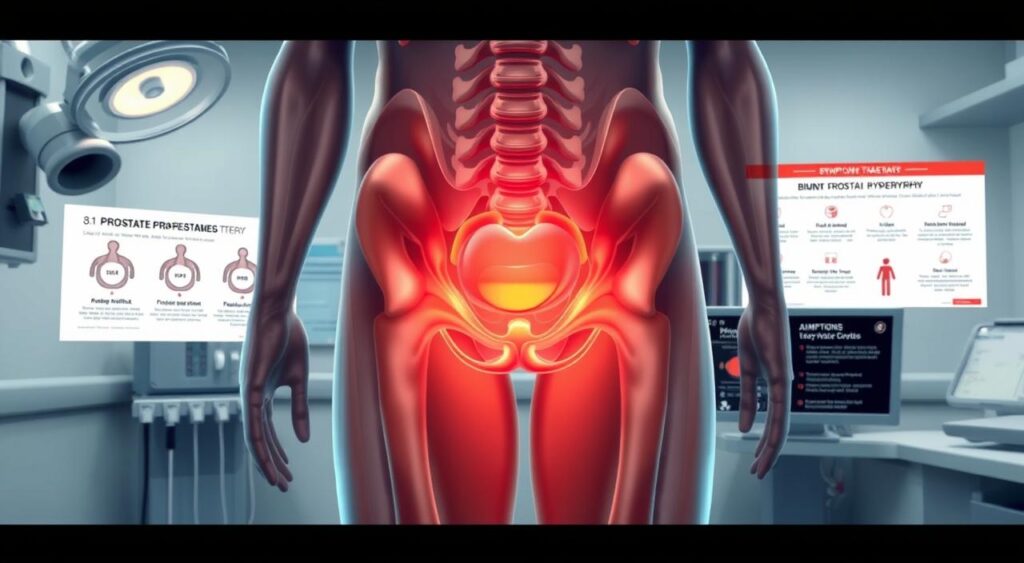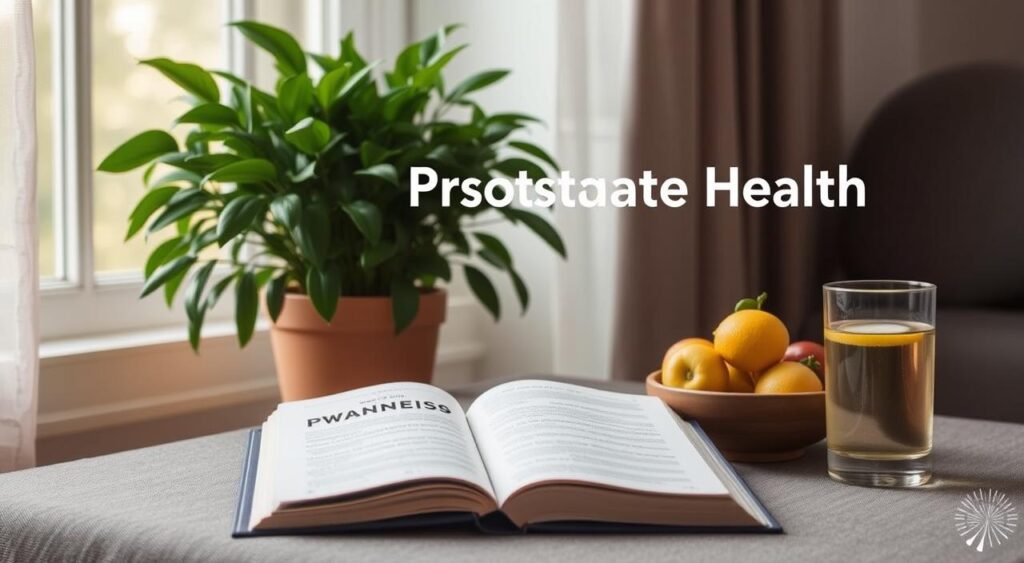About 50% of men over 50 face symptoms of benign prostatic hypertrophy. This condition affects the prostate gland. It’s a common issue that can really change a man’s life. As men get older, the chance of getting BPH goes up. It’s key to know the symptoms, causes, and how to treat it.

Knowing about BPH helps keep the prostate healthy. It can cause symptoms from mild to severe. There are ways to treat it, like medicine and surgery. By spotting the signs of BPH early, men can manage it better and avoid bigger problems.
Key Takeaways
- Benign prostatic hypertrophy affects 50% of men over 50
- BPH can significantly impact a man’s quality of life
- Understanding symptoms, causes, and treatment options is essential for managing BPH
- Benign prostatic hypertrophy can be treated with medication and surgery
- Recognizing signs and symptoms of BPH can help prevent complications
- Early detection and treatment can improve overall health and well-being
Understanding Benign Prostatic Hypertrophy (BPH)
Benign Prostatic Hypertrophy, or BPH, is a condition where the prostate gland gets bigger. This can lead to symptoms that affect a man’s life quality. As men age, their prostate gland can grow, causing BPH. This is common in men over 50, with the risk going up with age.
Millions of men worldwide deal with BPH symptoms. It can make daily life hard, causing discomfort and pain. Knowing about BPH is key to managing it and improving health.
Definition and Basic Concepts
BPH is not cancer, but it can still cause a lot of discomfort. Symptoms include needing to urinate often, having a weak urine flow, and trouble starting or stopping urination. These symptoms can really affect a man’s life.
Prevalence and Risk Factors
Age, family history, and lifestyle play big roles in BPH risk. As men get older, the chance of getting BPH goes up. A family history of BPH and certain lifestyle choices, like a diet full of saturated fats and not exercising, can also raise the risk.
| Risk Factor | Description |
|---|---|
| Age | The risk of BPH increases with age, with most cases occurring in men over 50. |
| Family History | A family history of BPH can increase a man’s risk of developing the condition. |
| Lifestyle Factors | A diet high in saturated fats and lack of exercise can increase the risk of BPH. |
Impact on Quality of Life
BPH can really impact a man’s life, causing discomfort and pain. Understanding the condition and getting medical help can help manage symptoms. This can improve a man’s overall well-being.
The Anatomy of the Prostate Gland
The prostate gland is key to prostate health. Knowing its anatomy helps us understand BPH. It’s a small gland, about the size of a walnut, found below the bladder and in front of the rectum.
The gland’s location and shape are important for prostate health. It wraps around the urethra. When it grows, it can cause BPH symptoms. Key parts of the prostate gland include:
- Location: below the bladder and in front of the rectum
- Structure: surrounds the urethra
- Function: produces fluids that make up semen
Keeping the prostate gland healthy is vital. When it grows, it can press on the urethra. This can cause symptoms like needing to urinate often and weak urine flow. Knowing the prostate gland’s anatomy is key to finding good treatments and keeping it healthy.
Common Signs and Symptoms of BPH
It’s important to know the signs of bph symptoms early. This helps in getting the right treatment. Each person may show different symptoms, but most men face urinary or physical issues. Spotting these signs can lead to timely medical help.
Urinary symptoms like trouble starting to pee, weak flow, and needing to pee a lot are common. These can make daily life hard. Some men also feel pain or discomfort in their pelvic area.
Urinary Symptoms
- Difficulty starting urination
- Weak urine flow
- Frequent urination
Physical Symptoms
Physical symptoms include pain or discomfort in the pelvic area. Seeing a doctor is key if these symptoms don’t go away or get worse.
When to See a Doctor
If you notice any of these symptoms, seeing a doctor is crucial. Early diagnosis and treatment can prevent bigger problems and improve your life.
Risk Factors and Causes
Benign prostatic hyperplasia is a complex condition. It is influenced by various factors. Age is a big risk factor, as the chance of getting it goes up with age. Genetics also matter, as people with a family history are more likely to get it.
Lifestyle choices, like diet and exercise, can also play a part. Hormonal changes might affect the prostate’s growth. Knowing these factors can help people prevent and manage the condition.
- Age: The risk of developing benign prostatic hyperplasia increases with age.
- Genetics: A family history of the condition can increase an individual’s risk.
- Lifestyle factors: Diet and physical activity can contribute to the development of benign prostatic hyperplasia.
Understanding the causes and risk factors of benign prostatic hyperplasia helps. People can lower their risk by making healthy lifestyle choices. This includes eating well and staying active. They should also see a doctor if symptoms don’t go away.
| Risk Factor | Description |
|---|---|
| Age | The risk of developing benign prostatic hyperplasia increases with age. |
| Genetics | A family history of the condition can increase an individual’s risk. |
| Lifestyle factors | Diet and physical activity can contribute to the development of benign prostatic hyperplasia. |
Diagnosis Methods for BPH
Diagnosing Benign Prostatic Hypertrophy (BPH) uses physical exams, lab tests, and imaging studies. These tools help spot BPH and rule out other possible causes of symptoms. Getting the right diagnosis is key for treating BPH well.
A physical exam is often the first step. It might include a digital rectal exam (DRE) to check the prostate’s size and feel. The doctor might also do a urine flow test to see how fast and strong the urine stream is.
Laboratory Tests
Labs play a big role in diagnosing BPH. They include:
- Prostate-specific antigen (PSA) test
- Complete blood count (CBC)
- Urinalysis
Imaging Studies
Imaging like ultrasound helps see the prostate and nearby tissues. It’s useful for diagnosing BPH and checking for other issues, like cancer.
In summary, diagnosing BPH needs a mix of physical exams, lab tests, and imaging. These tools help doctors find the right treatment for BPH. This improves the lives of those with BPH.
| Diagnostic Tool | Description |
|---|---|
| Physical Examination | Assesses the size and texture of the prostate gland |
| Laboratory Tests | Includes blood tests, such as PSA and CBC |
| Imaging Studies | Includes ultrasound to visualize the prostate gland |
Medical Treatment Options
For those dealing with prostate issues, there are medical treatments to help. These include medications like alpha-blockers and 5-alpha-reductase inhibitors. They are often used to treat prostate problems.
These drugs help relax the muscles in the prostate and bladder neck. This makes it easier to pee. They can also shrink the prostate, easing symptoms. Some benefits include:
- Improved urine flow
- Reduced frequency of urination
- Decreased risk of complications
Talking to a doctor about these medications is key. Side effects can differ from person to person. A healthcare provider can help find the right treatment for you.

Regular doctor visits are important. They help check if the treatment is working and make changes if needed. Taking care of prostate issues can lower the risk of serious problems and improve life quality.
| Treatment Option | Benefits | Potential Side Effects |
|---|---|---|
| Alpha-blockers | Improved urine flow, reduced frequency of urination | Dizziness, headache, nausea |
| 5-alpha-reductase inhibitors | Reduced prostate size, improved symptoms | Decreased libido, erectile dysfunction |
Surgical Interventions for BPH
When medical treatments don’t work, surgery might be needed for BPH. BPH is a common issue in men, and surgery can help a lot. There are many surgical options, each with its own benefits and risks.
Surgery is considered when BPH symptoms are very bad and affect daily life. The aim is to remove the enlarged part of the prostate gland. This helps to improve urine flow. There are both traditional and minimally invasive surgery options.
Traditional Surgery Options
Traditional surgeries, like transurethral resection of the prostate (TURP), remove the enlarged prostate through the urethra. This is done under general anesthesia and requires a hospital stay.
Minimally Invasive Procedures
Minimally invasive procedures, like laser surgery, are less invasive. They often cause less bleeding and have faster recovery times. These use advanced technology to remove the prostate tissue, reducing risks.
After surgery, following a proper recovery plan is key. This includes taking medications, attending follow-ups, and making lifestyle changes. These steps help manage BPH symptoms.
Understanding the surgical options for BPH helps men make informed choices. It’s a step towards better symptoms and quality of life.
Natural Remedies and Alternative Treatments
Men with an enlarged prostate might find relief in natural remedies and alternative treatments. These can be used alongside traditional medical care. Eating more fruits and veggies and cutting down on fats and sugars are good starts.
Supplements like saw palmetto and lycopene might help too. But, always talk to a doctor before trying new supplements. A healthy diet and lifestyle can also ease enlarged prostate symptoms.
Options like acupuncture and herbal remedies are also worth exploring. It’s important to talk to a healthcare provider about these choices. This way, men with an enlarged prostate can manage their symptoms better and feel better overall.
Lifestyle Changes for Managing BPH
Managing Benign Prostatic Hypertrophy (BPH) needs a full plan that includes lifestyle changes. A healthy lifestyle can greatly help prostate health and lessen bph symptoms. By making a few easy changes, people can lower their risk of BPH and live better.
Dietary Modifications
Eating right is key for prostate health. Foods high in sugar and fats can make bph symptoms worse. But, foods like fruits, veggies, and whole grains can help. Here are some diet tips:
- Drink less caffeine and alcohol
- Eat more omega-3 fatty acids
- Choose foods full of antioxidants, like berries and leafy greens
Exercise Recommendations
Regular exercise is also vital for prostate health and easing bph symptoms. It can make urination better, reduce swelling, and boost health. Good exercises include:
- Brisk walking
- Swimming
- Cycling

Bladder Training Techniques
Bladder training can help BPH symptoms and improve life quality. These methods include:
| Technique | Description |
|---|---|
| Urinary retention | Holding urine longer to strengthen bladder muscles |
| Double voiding | Voiding, then waiting a few minutes to void again for full emptying |
By adding these lifestyle changes, people can actively manage their BPH and enhance their prostate health.
Complications and Long-term Outlook
Benign prostatic hyperplasia (BPH) can lead to serious problems if not treated. Prostate issues can cause urinary tract infections, bladder stones, and kidney damage. It’s important to see a doctor if symptoms don’t get better or get worse.
Effective bph treatment can ease symptoms and stop long-term problems. Some possible issues with BPH include:
- Urinary tract infections
- Bladder stones
- Kidney damage
- Urinary retention
Getting a diagnosis early and treating it right is key. By getting medical help and following a bph treatment plan, men can lower their risk of complications. This improves their quality of life.
It’s vital to work with a healthcare provider to create a treatment plan that fits your needs. With the right treatment and care, men with BPH can live active and healthy lives.
Prevention Strategies
While we can’t stop benign prostatic hypertrophy (BPH) completely, making lifestyle changes can help. Eating well and staying active are key to staying healthy. They might also help prevent BPH.
Eating lots of fruits, veggies, and whole grains can lower BPH risk. Omega-3 fatty acids in fish like salmon are good for fighting inflammation. This could ease BPH symptoms. Also, exercising regularly, like walking or jogging, boosts health and lowers BPH risk.
Diet and Nutrition
- Eat a balanced diet rich in fruits, vegetables, and whole grains
- Incorporate omega-3 fatty acids into your diet
- Limit intake of saturated and trans fats
Physical Activity
Staying active is good for your health and can lower BPH risk. Try to do at least 30 minutes of moderate exercise daily. This could be brisk walking or cycling.
Regular Screenings
Getting regular check-ups is key to catching BPH early. Men over 50 should get prostate exams and talk to their doctor about risks. By following these tips, you can lower your BPH risk and stay healthy.
Conclusion
Understanding benign prostatic hypertrophy (BPH) is key for men’s prostate health. Knowing the symptoms and causes helps men manage BPH well. Regular health checks and lifestyle changes can reduce BPH’s effects.
By being proactive, men can improve their quality of life. Early action is vital in dealing with BPH, a common issue as men age.
FAQ
Q: What is Benign Prostatic Hypertrophy (BPH)?
A: Benign Prostatic Hypertrophy (BPH) is a non-cancerous enlargement of the prostate gland. It’s a common condition that affects many men, especially as they age.
Q: What are the symptoms of BPH?
A: Symptoms of BPH include trouble starting to urinate and a weak urine flow. You might also find yourself needing to urinate more often. Feeling like you haven’t fully emptied your bladder is another symptom.
Q: What causes BPH?
A: The exact cause of BPH is not fully understood. It’s believed to be related to hormonal changes and aging. Risk factors include age, family history, and certain lifestyle choices.
Q: How is BPH diagnosed?
A: Doctors diagnose BPH through a physical exam, lab tests, and imaging studies. These include a digital rectal exam, a prostate-specific antigen (PSA) test, and an ultrasound.
Q: What are the treatment options for BPH?
A: Treatment options include medications like alpha-blockers and 5-alpha-reductase inhibitors. There are also minimally invasive and traditional surgical options, depending on the severity.
Q: Can lifestyle changes help manage BPH?
A: Yes, making lifestyle changes can help manage BPH symptoms. This includes dietary modifications, regular exercise, and bladder training techniques. These can complement medical treatments.
Q: What are the potential complications of untreated BPH?
A: Untreated BPH can lead to urinary tract infections, bladder stones, and kidney damage. Seeking timely medical attention is crucial to avoid these complications.
Q: Can BPH be prevented?
A: While BPH can’t be prevented entirely, taking proactive measures can help. A healthy diet, regular exercise, and routine prostate screenings may delay or reduce the risk of developing BPH.
